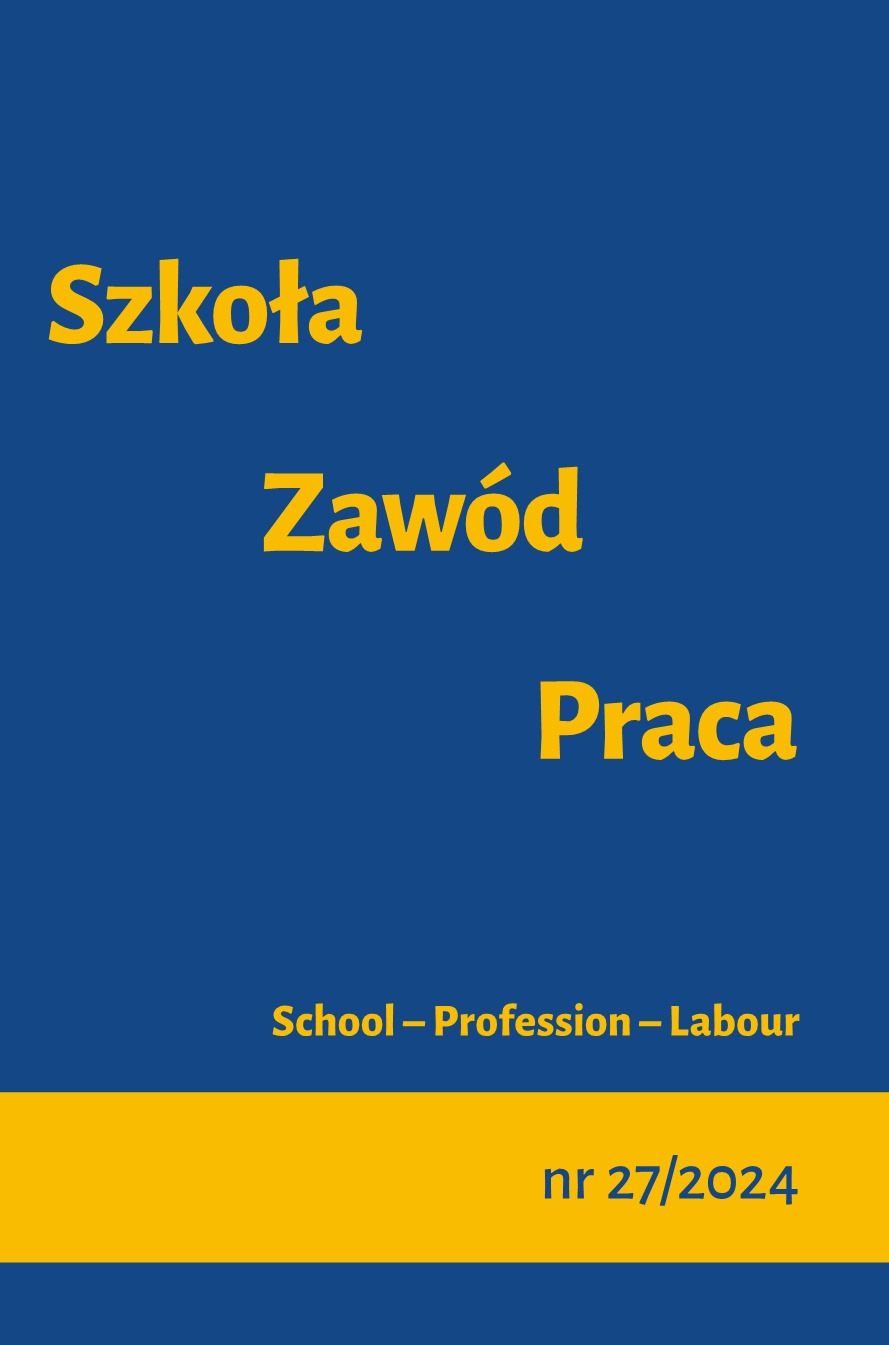Socioeconomic situation of hearing and deaf youth during the COVID-19 pandemic
DOI:
https://doi.org/10.34767/SZP.2024.01.07Keywords:
socioeconomic situation, hearing youth, deaf youth, COVID-19 pandemicAbstract
The paper is empirical in nature. The aim of the study was to answer the question, ‘How do hearing and deaf young people perceive their socioeconomic situation during the COVID-19 pandemic?’ Hearing adolescents (98 participants – 65.3%) and deaf adolescents (52 participants – 34.7%) participated in the study. The subject of the research was the socio-economic status of the families of the young people covered by the study. The research was exploratory in nature. A diagnostic survey with elements of questionnaire technique was used as a research method. Moreover, an original survey tool was used, i.e. a survey questionnaire prepared to collect data online. The analysis of the empirical material made it possible to learn about the knowledge and opinions of adolescents on those criteria that determine the assessment of the socioeconomic situation of the family during the COVID-19 pandemic. The concluding section presents conclusions for pedagogical practice.
References
Aassve, A., Alfani, G., Gandolfi, F., Le Moglie, M. Epidemics and trust: the case of the Spanish Flu. Health Economics, 30(4) (2021), https://ideas.repec.org/a/wly/hlthec/v30y2021i4p840-857.html (2.09.2023).
Armour, C., McGlinchey, E., Butter, S., McAloney-Kocaman, K., McPherson, K.E. The COVID-19 psychological wellbeing study: understanding the longitudinal psychosocial impact of the COVID-19 pandemic in the UK. A methodological overview paper. Journal of Psychopathology and Behavioral Assessment, 43(1) (2021).
Bischetti, L., Canal, P., Bambini, V. Funny but aversive: a large-scale survey of the emotional response to COVID-19 humor in the Italian population during the lockdown. Lingua, 249 (2021).
Celik, S., Köse, G.G. Mediating effect of intolerance of uncertainty in the relationship between coping styles with stress during pandemic (COVID-19) process and compulsive buying behavior. Progress in Neuro-Psychopharmacology and Biological Psychiatry, 110 (2021).
Czarnecka, M., Żelazkowska, M. (2021). Ocena funkcjonowania psychicznego dzieci po powrocie do nauczania stacjonarnego – rekomendacje psychopedagogiczne. W: A. Najda, M. Czarnecka, A. Regulska (red.), Rodzina i szkoła wobec pandemii COVID-19. Toruń: Adam Marszałek.
Dąbkowska, M. Psychospołeczne konsekwencje pandemii koronawirusa (COVID-19) u dzieci i młodzieży – przegląd wybranych opracowań. Niepełnosprawność. Dyskursy Pedagogiki Specjalnej, 39 (2020).
Drozdowski, R., Frąckowiak, M., Krajewski, M., Kubacka, M., Luczys, P., Modrzyk,A., Rogowski, Ł., Rura, P., Stamm, A. (2020). Życie codzienne w czasach pandemii. Raport z drugiego etapu badań. Wersja pełna. Poznań.
Field, A. (2021). The lasting impact of COVID-19 by generation. Daytona Beach: Brown& Brown Insurance, https://www.bbinsurance.com/wp-content/uploads/2021/05/Brown-Brown-Lasting-Impact-of-COVID-by-Generation-White-Paper.pdf (2.09.2023).
Friedrich, R., Peterson, M., Koster, A. The rise of Generation C. Strategy+Business, 62 (2011), https://www.strategy-business.com/article/11110 (2.09.2023).
Gambin, M., Sękowski, M., Woźniak-Prus, M., Cudo, A., Hansen, K., Gorgol, J., Huflejt--Łukasik, M., Kmita, G., Kubicka, K., Łyś, A.E., Maison, D., Oleksy, T., Wnuk, A. (2020).Uwarunkowania objawów depresji i lęku uogólnionego u dorosłych Polaków w trakcie epidemii COVID-19 – raport z pierwszej fali badania podłużnego. Warszawa: UW.
Goldberstein, E., Wen, H., Miller, B.F. Coronavirus Disease 2019 (COVID-19) and mental health for children and adolescents. JAMA Pediatrics, 175(9) (2020).
Golemis, A., Voitsidis, P., Parlapani, E., Nikopoulou, V.A., Tsipropoulou, V., Karamouzi,P., Giazkoulidou, A., Dimitriadou, A., Kafetzopoulou, Ch., Holeva, V., Diakogiannis,I. Young adults’ coping strategies against loneliness during the COVID-19-related quaran-tine in Greece. Health Promotion International, 37(1) (2022).
Güzel, P., Yildiz, K., Esentas, M., Zerengök, D. ‘Know-How’ to spend time in home isolationduring COVID-19. Restrictions and recreational activities. International Journal of Psychology and Educational Studies, 7(2) (2020).
Karaśkiewicz, A. (2021). O trudnych zadaniach uczniów, nauczycieli i rodziców – w odpowiedzi na diagnozę szkoły w czasach pandemii. W: A. Najda, M. Czarnecka, A. Regulska (red.), Rodzina i szkoła wobec pandemii COVID-19. Toruń: Adam Marszałek.
Kubacka-Jasiecka, D., Passowicz, P. Dorastanie we współczesności. Postawy, wartości i doświadczanie czasu a kryzysy rozwoju pokolenia po transformacji. Czasopismo Psychologiczne, 20(2) (2014).
Kutwa, K. (2021). Corona Generation. Growing up in a pandemic, cooperation: A. Kubisiak, J. Suwalski. Warszawa: Polish Economic Institute.
Kwieciński, Z. (2002). Wykluczanie. Toruń: UMK.
Lepenies, W. (1997). Trzy kultury. Socjologia między literaturą a nauką, tłum. K. Krzemieniowa. Poznań: Wyd. Poznańskie.
Liem, A., Wang, C., Wariyanti, Y., Latkin, C.A., Hall, B.J. The neglected health of international migrant workers in the COVID-19 epidemic. Lancet Psychiatry, 7(4) (2020).
Lifshin, U., Mikulincer, M. Further evidence for motivated helplessness in the context of the COVID-19 outbreak: the case of Argentina before and during the pandemic. The Journal of Social Psychology, 161(4) (2021).
Marchetti, M., Gatti, D., Inguscio, L., Mazzoni, G. Psychological well-being and lockdown: a study on an Italian sample during the first COVID-19 wave. Psychology HUB. Special Issue Effect of COVID-19 pandemic: vulnerability and resources. Part 2, 39(1) (2022).
Panayiotou, G., Panteli, M., Leonidou, C. Coping with the invisible enemy. The role of emotion regulation and awareness in quality of life during the COVID-19 pandemic. Journal of Contextual Behavioral Science, 19(10) (2021).
Restubog, S.L.D., Ocampo, A.C.G., Wang, L. Taking control amidst the chaos. Emotion regulation during the COVID-19 pandemic. Journal of Vocational Behavior, 119 (2020).
Rider, E.A., Ansari, E., Varrin, P.H., Sparrow, J. Mental health and wellbeing of children and adolescents during the COVID-19 pandemic. BMJ, 374, n1730 (2021).
Sigler, T., Mahmuda, S., Kimpton, A., Loginova, J., Wohland, P., Charles-Edwards, E., Corcoran, J. The socio-spatial determinants of COVID-19 diffusion: the impact of globalization, settlement characteristics and population. Globalization and Health, 17 (2021).
Waniek, D. Mity założycielskie – mity polityczne. Ich znaczenie w kształtowania współczesnych środowisk. Państwo i Społeczeństwo, 2 (2011).


